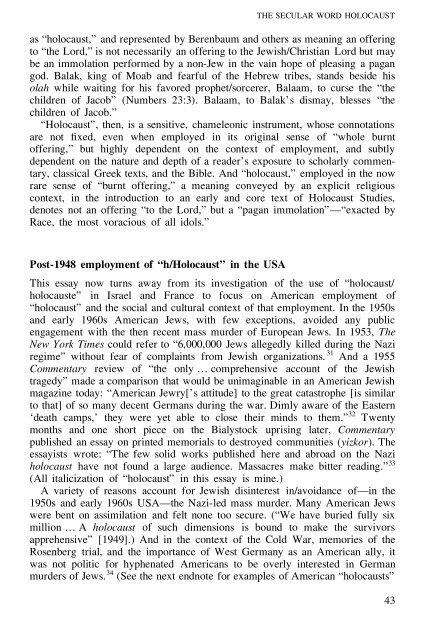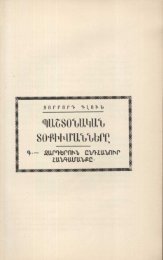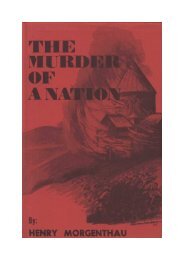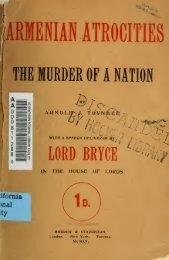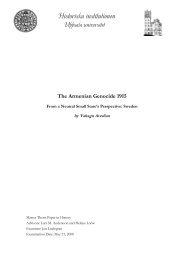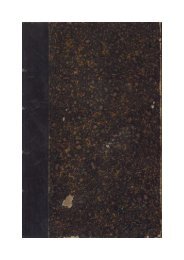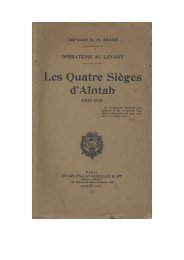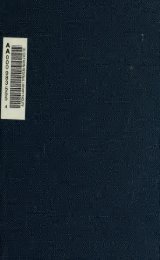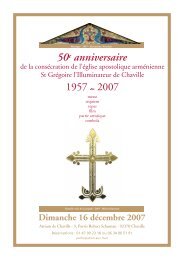The secular word HOLOCAUST: scholarly myths, history, and 20th ...
The secular word HOLOCAUST: scholarly myths, history, and 20th ...
The secular word HOLOCAUST: scholarly myths, history, and 20th ...
You also want an ePaper? Increase the reach of your titles
YUMPU automatically turns print PDFs into web optimized ePapers that Google loves.
THE SECULAR WORD <strong>HOLOCAUST</strong>as “holocaust,” <strong>and</strong> represented by Berenbaum <strong>and</strong> others as meaning an offeringto “the Lord,” is not necessarily an offering to the Jewish/Christian Lord but maybe an immolation performed by a non-Jew in the vain hope of pleasing a pagangod. Balak, king of Moab <strong>and</strong> fearful of the Hebrew tribes, st<strong>and</strong>s beside hisolah while waiting for his favored prophet/sorcerer, Balaam, to curse the “thechildren of Jacob” (Numbers 23:3). Balaam, to Balak’s dismay, blesses “thechildren of Jacob.”“Holocaust”, then, is a sensitive, chameleonic instrument, whose connotationsare not xed, even when employed in its original sense of “whole burntoffering,” but highly dependent on the context of employment, <strong>and</strong> subtlydependent on the nature <strong>and</strong> depth of a reader’s exposure to <strong>scholarly</strong> commentary,classical Greek texts, <strong>and</strong> the Bible. And “holocaust,” employed in the nowrare sense of “burnt offering,” a meaning conveyed by an explicit religiouscontext, in the introduction to an early <strong>and</strong> core text of Holocaust Studies,denotes not an offering “to the Lord,” but a “pagan immolation”—“exacted byRace, the most voracious of all idols.”Post-1948 employment of “h/Holocaust” in the USAThis essay now turns away from its investigation of the use of “holocaust/holocauste” in Israel <strong>and</strong> France to focus on American employment of“holocaust” <strong>and</strong> the social <strong>and</strong> cultural context of that employment. In the 1950s<strong>and</strong> early 1960s American Jews, with few exceptions, avoided any publicengagement with the then recent mass murder of European Jews. In 1953, <strong>The</strong>New York Times could refer to “6,000,000 Jews allegedly killed during the Naziregime” without fear of complaints from Jewish organizations. 31 And a 1955Commentary review of “the only … comprehensive account of the Jewishtragedy” made a comparison that would be unimaginable in an American Jewishmagazine today: “American Jewry[’s attitude] to the great catastrophe [is similarto that] of so many decent Germans during the war. Dimly aware of the Eastern‘death camps,’ they were yet able to close their minds to them.” 32 Twentymonths <strong>and</strong> one short piece on the Bialystock uprising later, Commentarypublished an essay on printed memorials to destroyed communities (yizkor). <strong>The</strong>essayists wrote: “<strong>The</strong> few solid works published here <strong>and</strong> abroad on the Naziholocaust have not found a large audience. Massacres make bitter reading.” 33(All italicization of “holocaust” in this essay is mine.)A variety of reasons account for Jewish disinterest in/avoidance of—in the1950s <strong>and</strong> early 1960s USA—the Nazi-led mass murder. Many American Jewswere bent on assimilation <strong>and</strong> felt none too secure. (“We have buried fully sixmillion … A holocaust of such dimensions is bound to make the survivorsapprehensive” [1949].) And in the context of the Cold War, memories of theRosenberg trial, <strong>and</strong> the importance of West Germany as an American ally, itwas not politic for hyphenated Americans to be overly interested in Germanmurders of Jews. 34 (See the next endnote for examples of American “holocausts”43


